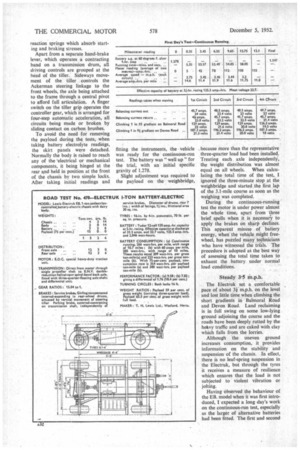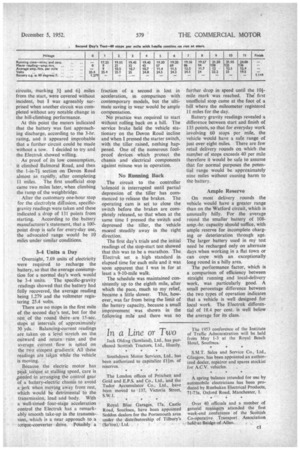mooth, Stable and Saf
Page 33

Page 34

Page 39

If you've noticed an error in this article please click here to report it so we can fix it.
The Electruk 1-tonner
By Laurence J. Cotton, M.I.R.T.E. PEDESTRIAN -CONTROLLED Jpattery-electric vehicles are intriguing, especially to mischievous children who swing on the side and try all the controls in the absence of the roundsman. Accidents have been caused in this way, but not with the Lewis Electruk EB. fourwheeler. It is unusually safe, because of the wide front and rear track and long wheelbase, which, in conjunc tion with a low centre of gravity, make for stability and smoothness on the road. In addition to the normal safeguards, the power key can be removed, and there is an optional fitting which locks the brakes while the vehicle is left unattended.
None of the precautions impairs the performance or adds to the total time of a delivery round. This I found during a test of the EB. model over "The Commercial Motor" standard course for electric vehicles at Watford, when it took 13 miles to exhaust the battery during a continuous run.
On the following day I walked a further 11 miles, making 60 quarterminute stops to the mile before the vehicle came to an involuntary halt. The second day's test occupied 61 hours, although a roundsman calling at houses at each stop would probably need at least 15 hours to cover the distance. The normal daily distance covered by a pedestrian controlled dairy float is three to six miles, so that the Electruk will cover the average round with ample capacity in hand.
The chassis is a selfsupporting structure with the motor mounted amidships, driving through an open propeller shaft to an E.N.V. double-reduction rear axle. A high-efficiency unit is used, having a helical-spur and spiral-bevel drive with a differential unit at the centre.
It has been found that with the driven rear axle, wheelspin does not occur, on gradients in winter. The driving axle is Mounted in plummer blocks, in which it can partially rotate in opposition to two single-leaf reaction springs which absorb starting and braking stresses.
Apart from a separate hand-brake lever, which operates a contracting band on a transmission drum, all driving controls are grouped at the head of the tiller. Sideways movement of the tiller• controls the Ackerman steering linkage to the front wheels, the axle being attached to the frame through a central pivot to afford full articulation. A finger switch on the tiller grip operates the controller gear, which is arranged for four-step automatic acceleration, all circuits being made or broken by sliding contact on carbon brushes.
To avoid the need for removing the payload during the tests, when taking battery electrolyte readings, the skirt panels were detached. Normally the body is raised to reach any of the 'electrical or mechanical components, it being hinged at the rear and held in position at the front of the chassis by two simple locks. After taking initial readings and fitting the instruments, the vehicle was ready for the continuous-run test. The battery was "well up" for the trial, with an initial specific gravity of 1.278.
Slight adjustment was required to the payload on the weighbridge,
_ because more than the representative three-quarter load had been installed. Treating each axle independently, the weight distribution was almost equal on all wheels. When calculating the total time of the test, I ignored the three-minute stop at the weighbridge and started the first lap of the 3.1-mile course as soon as the weighing was completed.
During the continuous-running test the motor is under power almost the whole time, apart from three brief spells when it is necessary to apply the brakes on sharp declines. This apparent misuse of battery energy, when the vehicle might freewheel, has puzzled many technicians who have witnessed the trials. The procedure is adopted as the best way of assessing the total time taken to exhaust the battery under normal load conditions.
Steady 3.5 M.p.h.
The Electruk set a comfortable pace of about 3i m.p.h. on the level and lost little time when climbing the short gradients in Balmoral Road and Devon Road. Land reclaiming is in full swing on some low-lying -ground adjoining the course and the roads have been deeply rutted by the helivy traffic and are caked with clay which falls from the lorries.
Although the uneven ground increases consumption, it provides information on the stability and suspension of the chassis. In effect, there is no leaf-spring suspension in the Electruk, but through the tyres it receives a measure of resilience which ensures that the load is not subjected to violent vibration or jolting.
Having observed the behaviour of the EB. model when it was first introduced, I expected a long day's work on the continuous-run test, especially as the larger of alternative batteries had been fitted. The first and second
circuits, marking 31 and 61 miles from the start, were covered without incident, but I was agreeably surprised when another circuit was completed without any notable change in the hill-climbing performance.
At this point the meters indicated that the battery was fast approaching discharge, according to the 3-hr. rating, and it appeared improbable that a further circuit could be made without a tow. I decided to try and the Electruk showed willing.
AS proof of its low consumption, it climbed Balmoral Road, and then the 1-in-7i section on Devon Road almost as rapidly, after completing 11 miles. The first unofficial stop came two miles later, when climbing the ramp of the weighbridge.
After the customary one-hour stop for the electrolyte diffusion, specificgravity readings were taken and these indicated a drop of 131 points from starting. According to the battery manufacturer's statement, that a 100point drop is safe for every-day use, the advocated range would be 10 miles under similar conditions.
3-4 Units a Day
Overnight, 7.69 units of electricity were required to recharge the battery, so that the average consumption for a normal day's work would be 3-4 units. The specific-gravity readings showed that the battery had fully recovered, the average reading being 1.279 and the voltmeter registering 25.4 volts.
There are no stops in the first mile of the second day's test, but for the rest of the round there are 15-sec, stops at intervals of approximately 30 yds. Balancing-current readings are taken on a level stretch on the outward and return runs, and the average current flow is noted on the two steepest gradients. All these readings are taken while the vehicle is moving.
Because the electric motor has peak torque at stalling speed, care is kieeded in arranging the control gear of a battery-electric chassis to avoid a 'jerk when moving away from rest, which would be detrimental to the transmission, load and body. With a well-timed four-stage acceleration control the Electruk has a remarkably smooth take-up in the transmission, which is a near approach to a torque-converter • drive. Possibly a fraction of a second is lost in acceleration, in comparison with contemporary models, but the ultimate saving in wear would be ample compensation.
No practice was required to start Without rolling back on a hill. The service brake held the vehicle stationary on the Devon Road incline and when I pressed the starter switch, with the tiller raised, nothing happened. One of the numerous foolproof devices which protect the chassis and electrical components against misuse was in operation.
No Running Back The circuit to the controller 'solenoid is interrupted until partial depression of the tiller has commenced to release the brakes. The operating cam is set to close the switch before the brakes are completely released, so that when at the same time I pressed the switch and depressed the tiller, the vehicle moved steadily away in the right direction.
The first day's trials and the initial readings of the stop-start test showed that this was to be a marathon. The Electruk set a high standard in elapsed time for each mile and it was soon apparent that I was in for at least a 9-10-mile walk.
The schedule was maintained consistently up to the eighth mile, after which the pace, much to my relief, became a little slower. This, however% was far from being the limit of the battery capacity, because a small improvement was shown in the following mile and there was no
further drop in speed until the 104mile mark was reached. The' first unofficial stop came at the foot of a hill where the mileometer registered 11 miles for the day.
Battery gravity readings revealed a difference between start and finish of 135 points, so that for everyday work involving 60 stops per mile, the vehicle would have a safe range of just over eight miles. There are few retail delivery rounds on which the number of stops exceeds 40 per mile therefore it would be safe to assume that for normal purposes the potential range would be approximately nine miles without causing harm to the battery.
Ample Reserve On most delivery rounds the vehicle would have a greater range than on the Watford circuit, which is unusually hilly. For the average round the smaller battery of 108amp-hr. capacity should suffice, with ample reserve for incomplete charging or deterioration through age. The larger battery used in my test need be recharged only on alternate days when working in a flat town or can cope with an exceptionally long round in a hilly area.
The performance factor, which is a comparison of efficiency between straight running and local-delivery work, was particularly good. A small percentage difference between the two types of operation indicates that a vehicle is well designed for local work. The Electruk differential of 18.4 per cent. is well below the average for its class.




















































































